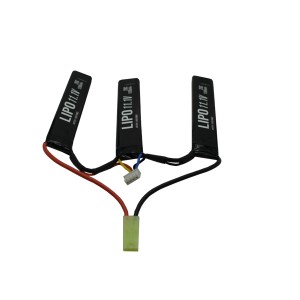The air gun has one of three power devices-spring piston, gas or automatic electric (abbreviated as AEG, automatic electric gun). That small air gun needs electricity, and it is obtained from some type of battery stored in the gun that is invisible. The cheap AEG runs on regular AA batteries. When guns become more advanced, they will use rechargeable batteries. Many AEGs that use rechargeable batteries are equipped with a battery pack and a charger, so the gun is complete. Today I will share with you some tips for choosing air gun batteries, I hope it will be helpful to everyone.
Voltage:
It’s very simple. The higher the voltage (ie 7.4v package), the higher the rate of fire
capacity:
Capacity (ie 1500Mah) will provide you with more runtime. It’s like your gas tank. The more Mah, the longer you can shoot people, and these will not affect your accuracy or FPS.
Battery chemical composition:
Electric enthusiasts use some chemicals. The most common are nickel metal hydride or nickel metal hydride. Li-Po or lithium polymer occupies an important position in RC applications and has also begun to take off in the air gun community. Many butts are equipped with low-quality Ni-MH or Ni-Cd batteries. Ni-Cad or nickel metal cadmium batteries are older technologies and are no longer as good as Ni-Mh and Li-Po battery packs. There are many different forms of lithium ion chemistry. For air guns, Ni-Mh is the best choice. If you buy the right battery and the price is reasonable, it is very powerful. I know there is a greater demand for Li-Po bags, but apart from the rate of fire, your only real gain is some weight reduction. Li-po has greater demand and fewer configuration options. In addition, in most cases, you cannot get the capacity of some packages. Li-po performed well, but it won’t be my first choice. They need more to be happy. For example, some type of low voltage detection to prevent each battery from falling below 3V. There is also a special charger/balancer. Nickel-metal hydride batteries 1.2 volts per section Ni-cadmium batteries 1.2 volts lithium polymer batteries per 3.7 volt lithium ion batteries range from 3.3 to 3.7 volts, depending on the specific chemical composition.
Battery quality/performance:
One thing I often object to is telling people that not all batteries fit what their label says. Many batteries are produced from very cheap factories, and the quality is very low. Usually, these are spare batteries that come with the air gun, or unnamed batteries. There are two reasons for this:
1: Inferior batteries have a short cycle life. This means you will get less fees from them. 2: They do not provide enough power. Even if the air gun is not a high-current drawing application, the battery cannot be located at the bottom of the barrel. So you need to choose the best air gun battery.
plug:
All these guns have crappy white plastic plugs. Whether it is a “big” or a “small” type, it is worthless. There is only 1 simple choice. Deans Super. There are other good plugs, but Deans is the most widely used and has proven its quality over the years. Why, you may ask, what plug to use is very important. Well, the reason is that the pins inside the plug are made of very thin tin, and in a short period of time, they will begin to wear and cause connection errors. This will cause the gun to sometimes fail to fire, and the battery will have false peaks on the charger. In addition, the plug is crimped, which is not necessarily a bad thing, but Deans is soldered, which is much better. When you use a better connection plug, you will significantly reduce your resistance and release some power that you didn’t have before. I have shown to people many times that my gun uses the same battery, the same voltage, and can get more energy with just a Deans plug. They could not believe that a small plug would limit such a large amount of power.
Charger/Charge:
Without a good charger, it is impossible to have a good battery. Good doesn’t mean you have to spend a lot of money, but you won’t spend 20 dollars to buy a good one. Generally speaking, most good chargers cost around US$50 or even higher. You will need something that has a variable charge rate (ampere) and is a peak detection charger. These are minimal. If you want to buy a Li-Po battery pack, you need something with a variable current setting, at least in 0.5 ampere increments, and a built-in balancer. Most of today’s chargers can accomplish all these tasks in one package. There are too many chargers on the market now, as long as you do as I said above, you won’t go wrong. You want to set the charger to the appropriate number of batteries, chemical composition, and charging current. Charging at a temperature of 1C and below is the safest choice. Example: 1C charge at 1500 mAh is 1.5 amps per charge. Therefore, for a 1500mah battery pack, anything 1.5 amps or less is safe. Another easy way to find C is to take the first 2 digits of Mah (or 15 if it is 1500 mah) and place your opinion between them. That will be 1C. Some chargers may have an Mv setting. This is your peak delta. You want each cell to be between 3-5mv. This is for Ni-MH battery packs. But most newer chargers will do this for you. If you are charging a Li-Po battery pack and the charger has a balancer, or you have an external balancer, it will be used every time you charge it. In fact, I tell all my clients always use balancers. We do not provide warranty for packages that we charge for none of them. Not charging is unsafe. You also charge Li-pos with 1C.
Post time: Nov-19-2021





